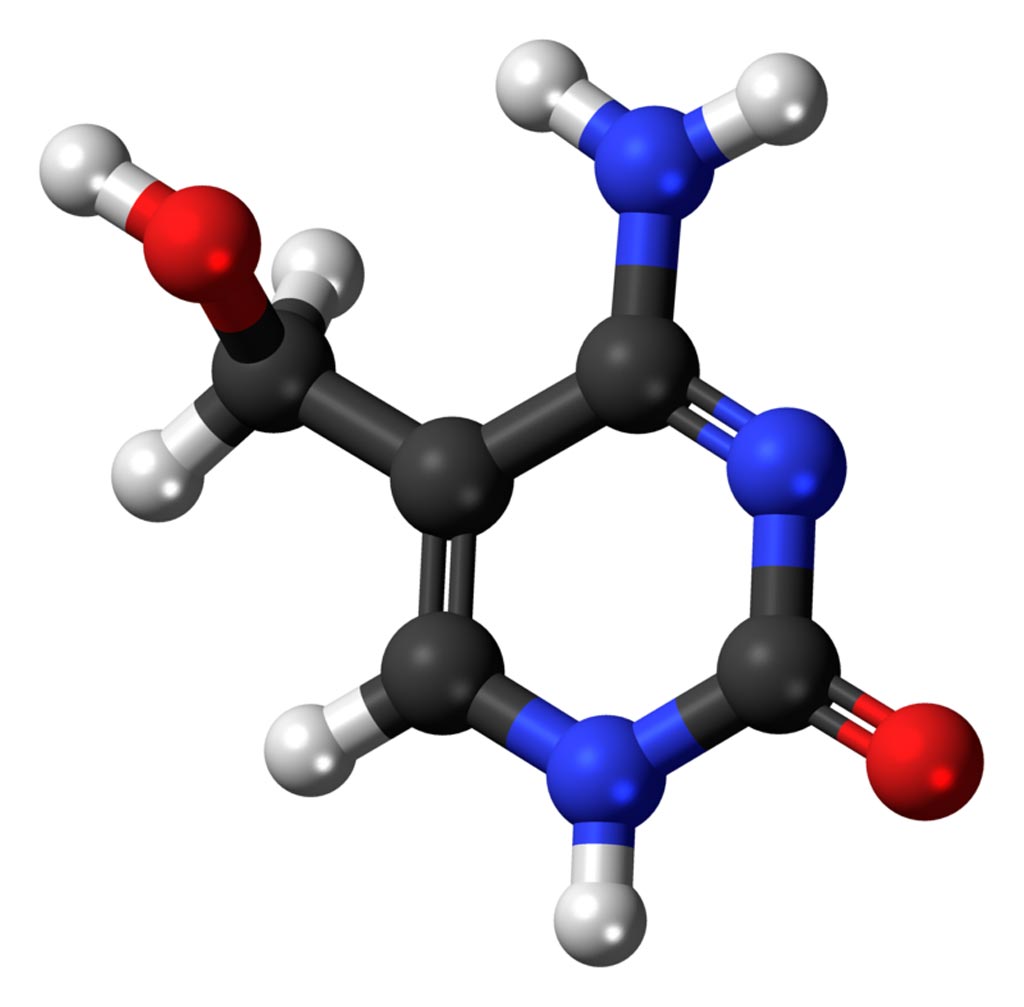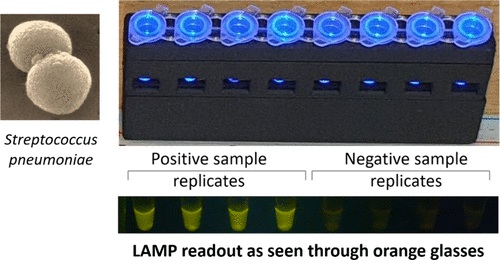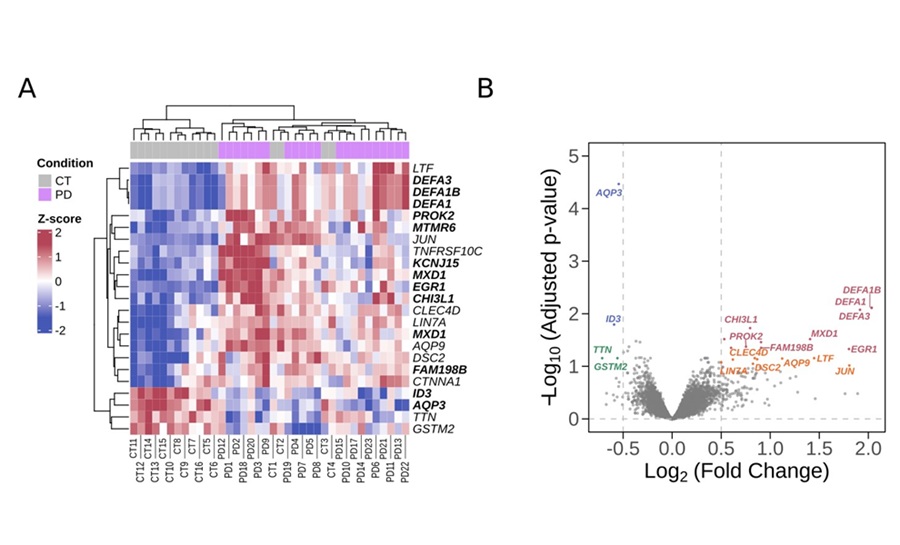NIV Test to Diagnose and Monitor Vascular Complications in Diabetes
|
By LabMedica International staff writers Posted on 07 Oct 2019 |

Image: A ball-and-stick model of the 5-hydroxymethylcytosine (5hmC) molecule (Photo courtesy of Wikimedia Commons).
By applying a sensitive test for analysis of DNA taken from patients with Type II diabetes, researchers were able to diagnose and monitor the presence and severity of diabetic vascular complications such as heart disease, atherosclerosis, and kidney failure.
About two-thirds of the 424 million diabetic patients worldwide die from vascular complications. Therefore, a clinically convenient, noninvasive approach for monitoring the development of these complications would improve the overall life quality of patients with Type II diabetes and help reduce healthcare burden through preventive interventions.
Investigators at Northwestern University (Chicago, IL, USA) had demonstrated previously that 5-hydroxymethylcytosine (5hmC), a relative stable intermediate product of active DNA demethylation, played a critical role in gene expression regulation and was also regarded as a novel epigenetic biomarker for cancer diagnosis and prognosis. They had invented TAB-seq, a method that could map 5hmC at base-resolution genome-wide, as well as hmC-Seal, a method that covalently labeled 5hmC for its detection. Furthermore, they introduced a sensitive and robust 5hmC sequencing approach which allowed genome-wide profiling of 5hmC using a limited amount of genomic DNA that could be readily isolated from only about 1,000 cells (nano-hmC-Seal).
The investigators applied this method to analyze three to five milliliter blood samples obtained from 62 diabetic patients (12 patients without vascular complications, 34 patients with a singular vascular complication, and 16 with multiple vascular complications).
Results revealed statistically significant changes in 5hmC markers associated with Type II diabetes-related macrovascular/microvascular complications, involving genes and pathways relevant to vascular biology and diabetes, including insulin resistance and inflammation. A 16-gene 5hmC marker panel accurately distinguished patients with vascular complications from those without, outperforming conventional clinical variables such as urinary albumin. In addition, a separate 13-gene 5hmC marker panel could distinguish patients with single complications from those with multiple complications, showing superiority over conventional clinical variables.
"We are very excited to apply our earlier findings in cancer patients to diabetic patients," said contributing author Dr. Wei Zhang, associate professor of cancer epidemiology and prevention at Northwestern University. "This discovery is going to revolutionize how quickly and non-invasively we can identify potentially fatal complications in the hundreds of millions of diabetic patients worldwide."
The work was published in the October 1, 2019, online edition of the journal Clinical Chemistry.
Related Links:
Northwestern University
About two-thirds of the 424 million diabetic patients worldwide die from vascular complications. Therefore, a clinically convenient, noninvasive approach for monitoring the development of these complications would improve the overall life quality of patients with Type II diabetes and help reduce healthcare burden through preventive interventions.
Investigators at Northwestern University (Chicago, IL, USA) had demonstrated previously that 5-hydroxymethylcytosine (5hmC), a relative stable intermediate product of active DNA demethylation, played a critical role in gene expression regulation and was also regarded as a novel epigenetic biomarker for cancer diagnosis and prognosis. They had invented TAB-seq, a method that could map 5hmC at base-resolution genome-wide, as well as hmC-Seal, a method that covalently labeled 5hmC for its detection. Furthermore, they introduced a sensitive and robust 5hmC sequencing approach which allowed genome-wide profiling of 5hmC using a limited amount of genomic DNA that could be readily isolated from only about 1,000 cells (nano-hmC-Seal).
The investigators applied this method to analyze three to five milliliter blood samples obtained from 62 diabetic patients (12 patients without vascular complications, 34 patients with a singular vascular complication, and 16 with multiple vascular complications).
Results revealed statistically significant changes in 5hmC markers associated with Type II diabetes-related macrovascular/microvascular complications, involving genes and pathways relevant to vascular biology and diabetes, including insulin resistance and inflammation. A 16-gene 5hmC marker panel accurately distinguished patients with vascular complications from those without, outperforming conventional clinical variables such as urinary albumin. In addition, a separate 13-gene 5hmC marker panel could distinguish patients with single complications from those with multiple complications, showing superiority over conventional clinical variables.
"We are very excited to apply our earlier findings in cancer patients to diabetic patients," said contributing author Dr. Wei Zhang, associate professor of cancer epidemiology and prevention at Northwestern University. "This discovery is going to revolutionize how quickly and non-invasively we can identify potentially fatal complications in the hundreds of millions of diabetic patients worldwide."
The work was published in the October 1, 2019, online edition of the journal Clinical Chemistry.
Related Links:
Northwestern University
Latest BioResearch News
- Genome Analysis Predicts Likelihood of Neurodisability in Oxygen-Deprived Newborns
- Gene Panel Predicts Disease Progession for Patients with B-cell Lymphoma
- New Method Simplifies Preparation of Tumor Genomic DNA Libraries
- New Tool Developed for Diagnosis of Chronic HBV Infection
- Panel of Genetic Loci Accurately Predicts Risk of Developing Gout
- Disrupted TGFB Signaling Linked to Increased Cancer-Related Bacteria
- Gene Fusion Protein Proposed as Prostate Cancer Biomarker
- Semen Exosome MicroRNA Proves Biomarker for Prostate Cancer
- Genetic Loci Link Plasma Lipid Levels to CVD Risk
- Newly Identified Gene Network Aids in Early Diagnosis of Autism Spectrum Disorder
- Link Confirmed between Living in Poverty and Developing Diseases
- Genomic Study Identifies Kidney Disease Loci in Type I Diabetes Patients
- Liquid Biopsy More Effective for Analyzing Tumor Drug Resistance Mutations
- New Liquid Biopsy Assay Reveals Host-Pathogen Interactions
- Method Developed for Enriching Trophoblast Population in Samples
- RNA-Based Test Developed for HPV Detection and Cancer Diagnosis
Channels
Clinical Chemistry
view channel
VOCs Show Promise for Early Multi-Cancer Detection
Early cancer detection is critical to improving survival rates, but most current screening methods focus on individual cancer types and often involve invasive procedures. This makes it difficult to identify... Read more
Portable Raman Spectroscopy Offers Cost-Effective Kidney Disease Diagnosis at POC
Kidney disease is typically diagnosed through blood or urine tests, often when patients present with symptoms such as blood in urine, shortness of breath, or weight loss. While these tests are common,... Read moreMolecular Diagnostics
view channel
New Diagnostic Method Detects Pneumonia at POC in Low-Resource Settings
Pneumonia continues to be one of the leading causes of death in low- and middle-income countries, where limited access to advanced laboratory infrastructure hampers early and accurate diagnosis.... Read more
Blood Immune Cell Analysis Detects Parkinson’s Before Symptoms Appear
Early diagnosis of Parkinson’s disease remains one of the greatest challenges in neurology. The condition, which affects nearly 12 million people globally, is typically identified only after significant... Read moreHematology
view channel
ADLM’s New Coagulation Testing Guidance to Improve Care for Patients on Blood Thinners
Direct oral anticoagulants (DOACs) are one of the most common types of blood thinners. Patients take them to prevent a host of complications that could arise from blood clotting, including stroke, deep... Read more
Viscoelastic Testing Could Improve Treatment of Maternal Hemorrhage
Postpartum hemorrhage, severe bleeding after childbirth, remains one of the leading causes of maternal mortality worldwide, yet many of these deaths are preventable. Standard care can be hindered by delays... Read more
Pioneering Model Measures Radiation Exposure in Blood for Precise Cancer Treatments
Scientists have long focused on protecting organs near tumors during radiotherapy, but blood — a vital, circulating tissue — has largely been excluded from dose calculations. Each blood cell passing through... Read moreImmunology
view channel
Blood-Based Liquid Biopsy Model Analyzes Immunotherapy Effectiveness
Immunotherapy has revolutionized cancer care by harnessing the immune system to fight tumors, yet predicting who will benefit remains a major challenge. Many patients undergo costly and taxing treatment... Read more
Signature Genes Predict T-Cell Expansion in Cancer Immunotherapy
Modern cancer immunotherapies rely on the ability of CD8⁺ T cells to rapidly multiply within tumors, generating the immune force needed to eliminate cancer cells. However, the biological triggers behind... Read moreMicrobiology
view channel
High-Throughput Enteric Panels Detect Multiple GI Bacterial Infections from Single Stool Swab Sample
Gastrointestinal (GI) infections are among the most common causes of illness worldwide, leading to over 1.7 million deaths annually and placing a heavy burden on healthcare systems. Conventional diagnostic... Read more
Fast Noninvasive Bedside Test Uses Sugar Fingerprint to Detect Fungal Infections
Candida bloodstream infections are a growing global health threat, causing an estimated 6 million cases and 3.8 million deaths annually. Hospitals are particularly vulnerable, as weakened patients after... Read morePathology
view channel
New Molecular Analysis Tool to Improve Disease Diagnosis
Accurately distinguishing between similar biomolecules such as proteins is vital for biomedical research and diagnostics, yet existing analytical tools often fail to detect subtle structural or compositional... Read more
Tears Offer Noninvasive Alternative for Diagnosing Neurodegenerative Diseases
Diagnosing and monitoring eye and neurodegenerative diseases often requires invasive procedures to access ocular fluids. Ocular fluids like aqueous humor and vitreous humor contain valuable molecular information... Read moreTechnology
view channel
Cell-Sorting Device Uses Electromagnetic Levitation to Precisely Direct Cell Movement
Sorting different cell types—such as cancerous versus healthy or live versus dead cells—is a critical task in biology and medicine. However, conventional methods often require labeling, chemical exposure,... Read more
Embedded GPU Platform Enables Rapid Blood Profiling for POC Diagnostics
Blood tests remain a cornerstone of medical diagnostics, but traditional imaging and analysis methods can be slow, costly, and reliant on dyes or contrast agents. Now, scientists have developed a real-time,... Read moreIndustry
view channel
Qiagen Acquires Single-Cell Omics Firm Parse Biosciences
QIAGEN (Venlo, Netherlands) has entered into a definitive agreement to fully acquire Parse Biosciences (Seattle, WA, USA), a provider of scalable, instrument-free solutions for single-cell research.... Read more
Puritan Medical Products Showcasing Innovation at AMP2025 in Boston
Puritan Medical Products (Guilford, ME, USA), the world’s most trusted manufacturer of swabs and specimen collection devices, is set to exhibit at AMP2025 in Boston, Massachusetts, from November 11–15.... Read more
Advanced Instruments Merged Under Nova Biomedical Name
Advanced Instruments (Norwood, MA, USA) and Nova Biomedical (Waltham, MA, USA) are now officially doing business under a single, unified brand. This transformation is expected to deliver greater value... Read more
























